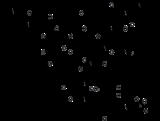
Telavancin
Encyclopedia
Telavancin is a bactericidal lipoglycopeptide
for use in MRSA or other Gram-positive
infections. Telavancin is a synthetic derivative of vancomycin
.
The FDA approved the drug in September 2009 for complicated skin and skin structure infections (cSSSI).
Food and Drug Administration
(FDA) issued an approvable letter for telavancin. Its developer, Theravance, submitted a complete response to the letter, and the FDA has assigned a Prescription Drug User Fee Act
(PDUFA) target date of 21 July 2008.
On 19 November 2008, an FDA antiinfective drug advisory committee concluded that they would recommend telavancin be approved by the FDA.
The FDA approved the drug on 11 September 2009 for cSSSI.
Theravance has also submitted telavancin to the FDA in a second indication, nosocomial pneumonia, sometimes referred to as hospital-acquired pneumonia, or HAP. The PDUFA goal date for this indication is 26 November 2009.
synthesis (see Pharmacology and chemistry of vancomycin). In addition, it disrupts bacterial membranes
by depolarization
.
in two clinical trials. It showed teratogenic effects in animal studies.
Lipoglycopeptide
Lipoglycopeptides are a class of antibiotic that have lipophilic side-chains linked to glycopeptides. The class includes oritavancin, telavancin and dalbavancin.Telavancin is the most potent of the 3 against Clostridium spp....
for use in MRSA or other Gram-positive
Gram-positive
Gram-positive bacteria are those that are stained dark blue or violet by Gram staining. This is in contrast to Gram-negative bacteria, which cannot retain the crystal violet stain, instead taking up the counterstain and appearing red or pink...
infections. Telavancin is a synthetic derivative of vancomycin
Vancomycin
Vancomycin INN is a glycopeptide antibiotic used in the prophylaxis and treatment of infections caused by Gram-positive bacteria. It has traditionally been reserved as a drug of "last resort", used only after treatment with other antibiotics had failed, although the emergence of...
.
The FDA approved the drug in September 2009 for complicated skin and skin structure infections (cSSSI).
History
On 19 October 2007, the USUnited States
The United States of America is a federal constitutional republic comprising fifty states and a federal district...
Food and Drug Administration
Food and Drug Administration
The Food and Drug Administration is an agency of the United States Department of Health and Human Services, one of the United States federal executive departments...
(FDA) issued an approvable letter for telavancin. Its developer, Theravance, submitted a complete response to the letter, and the FDA has assigned a Prescription Drug User Fee Act
Prescription Drug User Fee Act
The Prescription Drug User Fee Act was a law passed by the United States Congress in 1992 which allowed the Food and Drug Administration to collect fees from drug manufacturers to fund the new drug approval process...
(PDUFA) target date of 21 July 2008.
On 19 November 2008, an FDA antiinfective drug advisory committee concluded that they would recommend telavancin be approved by the FDA.
The FDA approved the drug on 11 September 2009 for cSSSI.
Theravance has also submitted telavancin to the FDA in a second indication, nosocomial pneumonia, sometimes referred to as hospital-acquired pneumonia, or HAP. The PDUFA goal date for this indication is 26 November 2009.
Mechanism of action
Like vancomycin, telavancin inhibits bacterial cell wallCell wall
The cell wall is the tough, usually flexible but sometimes fairly rigid layer that surrounds some types of cells. It is located outside the cell membrane and provides these cells with structural support and protection, and also acts as a filtering mechanism. A major function of the cell wall is to...
synthesis (see Pharmacology and chemistry of vancomycin). In addition, it disrupts bacterial membranes
Biological membrane
A biological membrane or biomembrane is an enclosing or separatingmembrane that acts as a selective barrier, within or around a cell. It consists of a lipid bilayer with embedded proteins that may constitute close to 50% of membrane content...
by depolarization
Depolarization
In biology, depolarization is a change in a cell's membrane potential, making it more positive, or less negative. In neurons and some other cells, a large enough depolarization may result in an action potential...
.
Adverse effects
Telavancin has a higher rate of kidney failure than vancomycinVancomycin
Vancomycin INN is a glycopeptide antibiotic used in the prophylaxis and treatment of infections caused by Gram-positive bacteria. It has traditionally been reserved as a drug of "last resort", used only after treatment with other antibiotics had failed, although the emergence of...
in two clinical trials. It showed teratogenic effects in animal studies.

